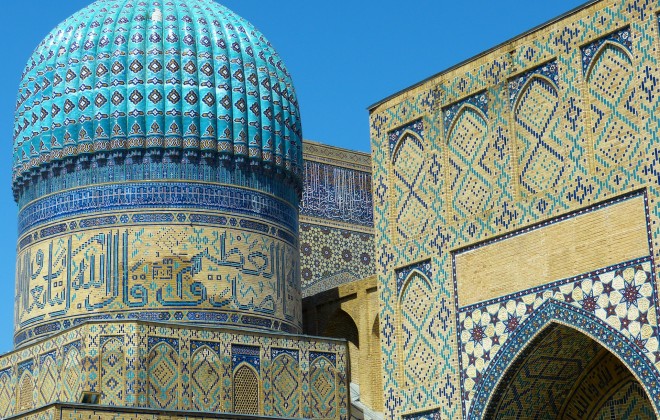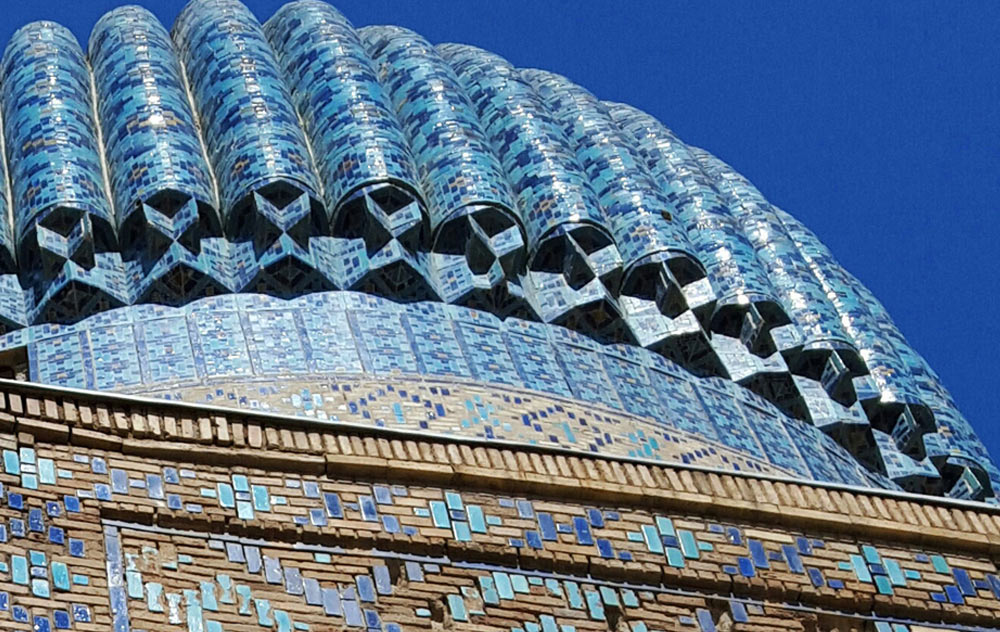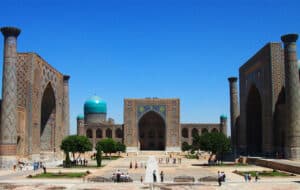Bibi Khanym Mosque Travel Guide
1. Introduction
Bibi-Khanym Mosque stands as a powerful reminder of Samarkand’s glorious Timurid era. Commissioned by the conqueror Timur (Tamerlane) at the height of his empire in the late 14th century, it was once among the largest mosques in the Islamic world. Though centuries of wear, earthquakes, and partial neglect have taken their toll, ongoing restorations still showcase the ambitious scale and artistry that once awed travelers from across Asia and beyond.
Historical Quote:
Ruy González de Clavijo, a Spanish diplomat who visited Samarkand in 1404, described Timur’s city as filled with “magnificent palaces and mosques,” noting that no place rivaled its splendor and grandeur.
2. A Glimpse into Its Past
Commissioning by Timur
- Patron’s Vision: Timur sought to build a mosque commensurate with his empire’s prestige. According to local lore, he demanded that “the mosque’s dome must rise to match the heavens,” reflecting his larger-than-life ambitions.
- Legend of Bibi-Khanym: One popular tale says the mosque was named after Timur’s favorite wife, Bibi-Khanym (sometimes spelled Bibi-Khanum). Some stories suggest she oversaw construction in his absence, leading to various romantic—and sometimes dramatic—legends about the project’s completion.
Intriguing Facts
- Record-Breaking Dimensions: At the time of its completion, the mosque’s main cupola was said to surpass most others in height, prompting comparisons to the famous structures of Isfahan and beyond.
- Earthquake Devastations: Over centuries, seismic activity severely damaged sections of the mosque. The dome collapsed more than once, yet periodic restoration efforts have helped reclaim parts of its original silhouette.
- Connection to the Silk Road: Samarkand was a major stop on the Silk Road, and pilgrims, traders, and envoys alike would pass through, marveling at Bibi-Khanym’s monumental proportions and intricate decoration.
Timur’s Alleged Boast:
“Were my empire to stretch from sunrise to sunset, so would the walls of this mosque.”
(Although this exact quote is attributed to Timur in local lore, it reflects his famed audacity and the legend surrounding the mosque’s construction.)
3. Planning Your Visit
Best Times to Go
- Spring (March–May): Comfortable temperatures and blooming flowers around the complex. Early mornings have fewer crowds.
- Summer (June–August): Can be hot, but early morning light is fantastic for photography.
- Autumn (September–November): Clear skies, moderate weather, and a beautiful golden glow for late-afternoon photos.
- Winter (December–February): Quiet and serene; if you don’t mind the chill, you can get unobstructed shots of the mosque’s grandeur.
Getting There
- By Air: Fly to Samarkand International Airport, then taxi (15–20 minutes) to the city center.
- By Train: High-speed Afrosiyob train from Tashkent takes ~2 hours. From Samarkand station, a short taxi or bus ride leads to Bibi-Khanym.
- By Road: Buses or private cars connect Samarkand with other Uzbek cities like Bukhara and Tashkent.
4. Entrance & Logistics
- Opening Hours: Typically 8:00 AM–7:00 PM. Hours might vary with seasons or special events.
- Ticket Price: Approximately 25,000–40,000 UZS for international visitors. Locals often pay a reduced fee; students or seniors may get discounts.
- Facilities: Modest restrooms and a small on-site gift stall are usually available. Nearby cafes and shops abound around the mosque and bazaar area.
5. Architectural Marvels to Notice
- Grand Portal (Iwan):
- Scale & Proportions: The grand entrance stands as a testament to Timur’s grandiose vision—towering, wide-arched, and richly adorned.
- Tilework & Calligraphy: Look for Persian-inspired floral motifs and Quranic verses in vivid blues and turquoises.
- Main Courtyard:
- Vast Open Space: Once capable of accommodating thousands of worshipers. Imagine it bustling during major religious festivals of the Timurid era.
- Marble Lectern (Kursi): Many believe Timur brought this massive marble stand from India; it once held an enormous Quran.
- Majestic Domes:
- Color Palette: Varying shades of azure, cobalt, and turquoise, typical of Timurid aesthetics.
- Engineering Feats: Early engineers used squinches and arches to support the great weight of the domes—remarkable for the 14th century.
- Restored Sections vs. Original Ruins:
- Preservation Efforts: Some parts have been carefully reconstructed with modern materials, while other sections remain partially ruined, offering an atmospheric contrast.
6. Photography Tips: Timing & Angles
Bibi-Khanym Mosque is a dream location for architectural photography. Here’s how to capture its essence:
- Morning Light (8:00–10:00 AM):
- Soft Shadows & Fewer Crowds: The angled sunlight highlights tile details without harsh glare.
- Courtyard Shots: Position yourself near the central courtyard, capturing the grand portal with fewer people around.
- Late Afternoon & Golden Hour (5:00–7:00 PM):
- Warm Tones & Dramatic Contrasts: The low sun bathes the domes in a golden glow, emphasizing their turquoise hues.
- Silhouette Opportunities: Use the archways or minarets to frame the sun, creating striking silhouettes.
- Vantage Points & Composition Ideas:
- Wide-Angle Lenses: Ideal for capturing the towering iwan and expansive courtyard.
- Symmetry & Center Framing: Align the central arch or dome in your frame for powerful symmetrical compositions.
- Close-Ups of Tiles: The elaborate mosaic patterns deserve attention. Zoom in or switch to a macro lens for detailed shots of inscriptions and floral motifs.
- Avoiding Crowds:
- Weekdays over Weekends: Samarkand receives more local visitors on weekends, so mid-week can be calmer.
- Patience is Key: Tour groups often move in clusters—wait for a lull between groups to get clean, people-free frames.
- Practical Advice:
- Tripod or No Tripod? Check local rules. Many outdoor areas allow tripods, but you may need to avoid blocking passageways.
- Respectful Photography: If you capture locals or worshippers, ask permission or do so discreetly to respect their privacy.
- Exposure Compensation: The contrast between the sky and the deep shadows of the arches can be stark; try bracketing your shots or adjusting exposure for best results.
7. Additional Tips for Exploring Bibi-Khanym
- Dress Appropriately: Although Uzbekistan is relatively moderate, respectful clothing—covering shoulders and knees—is appreciated, especially when entering sacred areas.
- Hydration & Sun Protection: Samarkand can get quite hot; carry water and wear sunscreen or a hat.
- Combine with Siab Bazaar: Right next to the mosque is one of the city’s liveliest bazaars, perfect for snapping vibrant local scenes and sampling fresh produce.
- Engage a Local Guide: A knowledgeable guide can regale you with the legends of Timur, Bibi-Khanym, and the Silk Road connections while pointing out subtle details in the mosque’s architecture.
8. Nearby Attractions
While in this historical district:
- Shah-i-Zinda Necropolis: A photogenic avenue of intricately tiled mausoleums.
- Registan Ensemble: Samarkand’s iconic centerpiece, featuring the Ulugh Beg, Sher-Dor, and Tilya-Kori madrasahs.
- Gur-e-Amir Mausoleum: The final resting place of Timur, renowned for its ornate interior and iconic blue dome.
9. Conclusion
Visiting the Bibi-Khanym Mosque is stepping into a chapter of Central Asian history where ambition met artistry. Its soaring arches, monumental proportions, and glittering tiles have enchanted travelers for centuries—from the caravan traders of the Silk Road to modern-day explorers with cameras in hand. Embrace the legends, let the grandeur sink in, and capture the mosaic of colors and stories with every photograph you take.
In Timur’s spirit:
“May this place stand as a mirror of our devotion and glory,” an echo of the grand ruler’s desire that the Bibi-Khanym Mosque be recognized through the ages.
Whether you’re drawn by the architectural majesty, the historical intrigue, or the dreamlike photo ops, Bibi-Khanym Mosque promises an unforgettable journey into Samarkand’s remarkable past—and a luminous present that every traveler can cherish.
Related Tours








